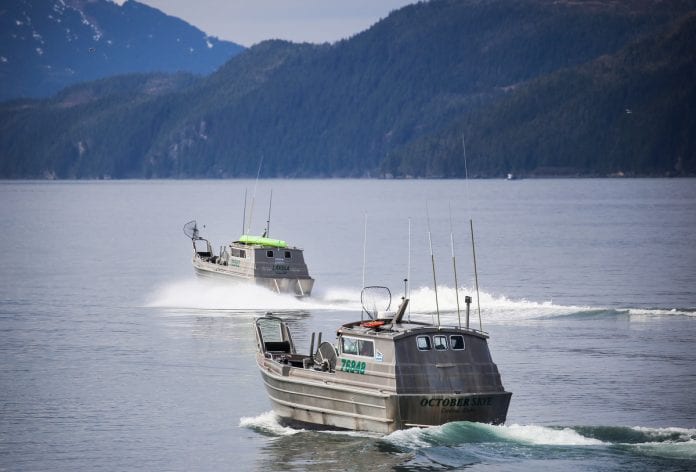
Before western contact, the first people who lived along Prince William Sound and on the Copper River Delta in and around villages included Eyak Lake, Alaganik, Palugvik and Nuchek, as well as many camps and villages throughout the Sound and the Copper River Delta. Subsistence and trade are a known part of tradition for hundreds of years, and were documented with early contact.
Spanish explorers, the very same who gave the contemporary names for ports such as Cordova and Fidalgo, documented trade with the Eyak Indians, and the most common item that the Spanish traded for was fish.
“Large flounder” (aka halibut) and salmon were taken in trade for durable goods, raw materials, as well as trade beads.
In a world with a large and growing population, and so much protein already produced in ways that are damaging to the environment, the Native Village of Eyak supported salmon stock enhancement in Prince William Sound decades ago. These methods provided an environmentally responsible means of feeding a world desperate for high-quality protein while providing greater opportunity for tribal fishermen to continue the tradition of benefitting from trade and commerce; a win-win!
Hatchery-based survival enhancement conforms with the Tribe’s ethic — seeing animals as peers who willingly sacrifice themselves for those who would harvest them with respect and deference. Contrasted against ocean farming which is practiced with the opposite set of values, at great harm to both wild and farmed salmon, or recreational fishing, where fish are stalked and taken, then returned to the water: salmon are not here for our amusement, nor are they to be domesticated; either is an abomination.
Thus, the region’s First People supported the investment of hundreds of millions of dollars in hatchery infrastructure in the early 1970s, including hatcheries in Prince William Sound which are now managed and operated by the Prince William Sound Aquaculture Corporation and the Valdez Fisheries Development Association (VFDA).
As hatcheries operated and generated harvestable, enhanced stocks, it became clear that there were interactions between wild and hatchery fish and a scientific panel was formed in 2011 to investigate these issues. In 2012 the Alaska Hatchery Research Project (AHRP) began collecting data through contracts with the Sitka Sound Science Center and the Prince William Sound Science Center, with the project ongoing, and scheduled to continue for several years. This project is an investment of tens of millions of dollars to ensure that our investment in hatchery infrastructure is used responsibly.
Recently, input from stakeholders in the larger region, outside of Prince William Sound, who have made redundant observations consistent with those that incepted the AHRP, inexplicably resulted in a proposal by the Kenai River Sportfish Association (KRSA) to reduce permitted production at VFDA.
We are extremely disturbed that these observations have been presented as occurring in pink salmon streams when all of these observations were recorded in systems that are not listed in Alaska’s Anadramous Waters Catalog as containing pink salmon, with the exception of Humpy Creek, whose stray rate was well below 3 percent. This is simply pink salmon schools exploring, and is nothing new.
As stewards of these resources for over 10,000 years, the Native Village of Eyak is greatly troubled by the amount of consideration for imposing a production restriction on a major hatchery outside of the normal process; a process which happens to be open and participatory.
NVE holds an ex-officio position on the Prince William Sound/Copper River Regional Planning Team (RPT), and we are supportive of the RPT process and the serious consideration that they give to issues pertaining to hatchery permitting and production. The proposal before the board of fish’s work session on October 16 delegitimizes the rigorous scientific process, and enormous investment made by the State of Alaska to determine the genetic stock structure of pink and chum salmon, the extent of straying, and the impact of hatchery straying on productivity of wild salmon via the AHRP. These are important questions that need to be resolved before solutions are imposed. What we are certain of, however, is that wild pink salmon returns were the most abundant ever recorded in 2013, then broke that record in 2015, and again in 2017.
Straying salmon is not news, this inherent biological trait is neither surprise nor emergency, and we have invested an incredible amount in our hatcheries and in the research to ensure that they are operated using best management practices. Undermining this investment is an enormous mistake, and legitimizing efforts to re-frame this issue as one requiring some remedy is irresponsible.
The Native Village of Eyak supports strong wild salmon stocks and maximum sustainable use of our natural resources. We strongly recommend that the Alaska Hatchery Research Project’s findings be used to inform best practices for the industry, and maintain the current egg-take plan approved by VFDA’s Production Planning Committee and reviewed by the Prince William Sound Regional Planning Team, so that this industry can continue to do good by feeding our members, our community and the world, and do well by providing greater access to the economic benefits of trade for our region.
Would the world’s needs be better met by a thousand more high-density feed lots or net pens full of Atlantic salmon? Ocean-grown salmon are among the greatest prospects for delivering the world the protein it needs. But our salmon will not be able to help meet these needs if their value is seen solely as recreational, or they are grown in pens.














